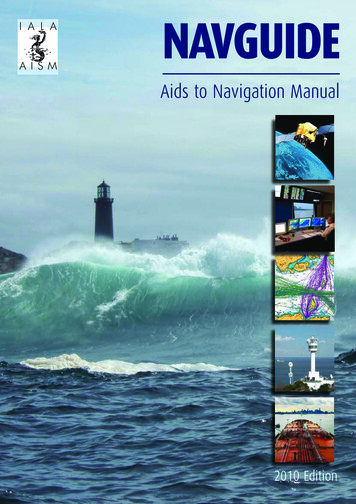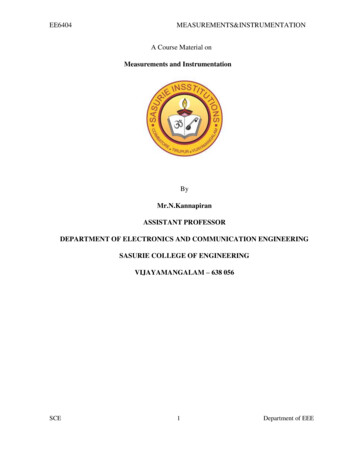
Transcription
NAVGUIDEAids to Navigation Manual2010 Edition
IALA Aids to Navigation ManualNAVGUIDE 2010AISM-IALA : 20 ter rue Schnapper - 78100 Saint-Germain en Laye - FranceTelephone: 33 1 34 51 70 01 - fax: 33 1 34 51 82 05e-mail : iala-aism@wanadoo.fr - internet: www.iala-aism.org IALA-AISM 2010Reproduction for training / educational purposes permitted.
ForewordThe IALA NAVGUIDE 2010 will be of interest and assistance to all organisations, training institutionsand individuals who are associated with aids to navigation (AtoN). This sixth edition has beendeveloped over the past four years (2006 – 2010), and represents a continuing commitment toexcellence and clarity of presentation.A key change from the 2006 version is the focus on e-navigation in recognition of the extensiveconceptual work done to date, the central role e-navigation is expected to play in the future workprogram of IALA and its impact on the way Competent Authorities provide an aids to navigationservice to mariners in the longer term.The IALA Aids to Navigation Management (ANM) Committee has coordinated the review of theIALA NAVGUIDE. All sections have been reviewed and revisions made through expert input fromall of the IALA Committees – ANM, Engineering, Environment and Preservation (EEP), e-Navigation(e-NAV) and Vessel Traffic Services (VTS).This NAVGUIDE is a tribute to professionals already very busy in their own organisations worldwide,who are happy to share their expertise with other members of the international maritime communityto assist in reaching the ultimate goal of harmonization of maritime aids to navigation. It is atestimony to the effort of all the members of the IALA Committees.IALA welcomes feedback about its publications. Readers are invited to send comments or suggestions,which will be taken into account when considering the publication of the next edition. Please forwardcomments to: iala-aism@wanadoo.fr attention IALA Technical Coordination Manager.Torsten Kruuse, IALA Secretary GeneralMarch 2010NAVGUIDE 2010i
AcknowledgementThe photographs in this manual were provided by members of the various IALA Committeesand Industrial Members of IALA acting either in their capacity as representatives of a memberorganisation or as private individuals. The photographs were accompanied by permission to publishthem in this manual; IALA wishes to acknowledge these donations and the copyright of donors.Donations were received from:Australian Maritime Safety AuthorityAustralian Maritime Systems LtdCanadian Coast GuardChina Maritime Safety AdministrationCommissioners of Irish LightsForce TechnologyInstituto Hydrografico (Portugal)Mobilis S.A.SNorthern Lighthouse Board (Scotland)Sabik OyTideland Signal CorporationTrinity House Lighthouse Service (UK)United States Coast GuardVega IndustriesWasser und Schiffahrtsdirektion (Germany)iiNAVGUIDE 2010
ContentsForewordiAcknowledgementiiChapter 1An Introduction to Iala – Aism11.1Purpose and Scope11.2Background11.3Membership21.4Iala Structure41.4.1Iala Council4Policy Advisory Panel61.4.2General es, Symposiums and ExhibitionsWorkshops and SeminarsIala Publications1.5.11.5.21.5.31.5.4Iala RecommendationsIala GuidelinesIala Manuals467889910Iala Dictionary10Related Organisations101.5.5Definitions12Glossary of Abbreviations13Chapter 2Concepts and Accuracy of Navigation152.1Navigational Methods152.2Accuracy Standards Ffor Navigation152.3Phases of Navigation162.3.2172.41.5.6Other Documentation2.3.1Ocean Navigation2.3.3Harbour Approach2.3.4Coastal NavigationRestricted Waters10161818Measurement Errors and Accuracy192.4.2202.4.1NAVGUIDE 2010Measurement ErrorAccuracy20iii
Contents2.5Hydrographic racy of Charts262.5.4Charted Buoy Positions26Chapter 3 Aids to Navigation3.13.2Visual Aids to Navigation3.1.1Signal Colours3.1.3Meteorological ility of a MarkAtmospheric TransmissivityAtmospheric RefractionContrastUse of BinocularsRange of a Visual MarkGeographical RangeAids to Navigation Lights3.2.1 Gas Lights3.2.2 Electric Lights3.2.3 Photometry of Marine Aids to Navigation Signal Lights3.2.4 Rhythms / Character3.2.5 Fixed Aids to Navigation3.2.6 Floating Aids to Navigation3.2.7 Sector Lights and Leading (Range) Lines3.2.8 Integrated Power Supply LanternsChapter 4 814.1Introduction814.2Definition of e-Navigation824.3A Vision for e-Navigation824.4Strategy and Implementation834.5Iala’s Role864.6Architecture864.7Technology for e-Navigation874.8Iala Plan87Electronic Position Fixing Systems874.9Global Navigation Satellite Systems (Gnss)4.9.1 Gps4.9.2 Glonass4.9.3 QzssIrnsS8990NAVGUIDE 2010
Contents4.10 Differential Gnss4.10.1 Iala Beacon Dgnss4.10.2 Sbas4.11 Receiver Autonomous Integrity Monitoring (Raim)4.12 Terrestrial – eLoran4.12.1 Introduction4.12.3 eLoran Performance4.12.2 Background4.12.4 Core eLoran Elements4.12.5 Compatibility Between eLoran and Loran-C4.12.6 eLoran as a Viable Backup to Gnss4.13Radar Aids to Navigation4.13.1 New Technology Radars4.13.2 Radar Reflectors4.13.3 Radar Target Enhancers4.13.4 Radar Beacon (Racon)4.13.5 Frequency-Agile Racon4.13.6 Performance Criteria4.13.7 Technical Considerations4.13.8 Use With New Technology Radars4.13.9 Non-Radio Positioning 99Communications100Long Range Identification and Tracking1004.14 Maritime Radio Communications Plan4.15 Introduction4.16 Lrit Concept4.17 Lrit Performance Standards And Functional RequirementsAutomatic Identification System4.18 Overview4.19 Purpose and Function4.20 System Characteristics4.21 Shipboard Ais4.22 Shore Based Ais4.23 Ais as an Aid to Navigation4.24 Carriage Requirements4.25 Cautions when using Ais4.26 Strategic Applications of Ais4.27 IALA-NET4.28 Electronic Chart Display and Information System (Ecdis)4.29 Maritime Information4.30 Aton Attribute Information4.31 Meteorological and Hydrological Information4.32 Intergovernmental Oceanographic CommissionNAVGUIDE 08109109110110v
ContentsChapter 5Vessel Traffic Services (Vts)1115.1Definition1115.2Services1115.3Vts System112Other Services and Facilities113Pilotage1136.1.2114Chapter 66.16.26.36.4Pilotage as a Service to Navigation6.1.3Other Pilotage Considerations6.1.4113Types of Pilotage114Simulation Pilot Training and Certification114Ships Routeing1166.2.21176.2.1Objectives6.2.3Vessel Manoeuvring116Definitions118Achieving A Minimum Comprehensive Mix of AtoN for Channels and Waterways1196.3.1Design Elements1206.3.3Hydrographic Considerations1216.3.26.3.46.3.5Dredging Considerations121Design Validation and Visualisation and the use of Related Tools121Economic Considerations122The Marking of Man-Made Offshore Structures1246.4.1Offshore Structures in General (Those not Included in Other Groups)1246.4.3Offshore Wind Farms1256.56.6vi6.1.16.4.26.4.4Offshore Aquaculture FarmsOffshore Wave and Tidal Energy Devices125127Sound Signals1286.5.21296.5.1Considerations on Sound Signals and their Use6.5.3Sound Signals in the World6.5.4Considerations on Fog DetectorsRange of a Sound Signal129129129Nautical Publications1316.6.21316.6.1Navigational Warnings6.6.3Lists of Aids to Navigation6.6.46.6.56.6.6World-Wide Navigational Warning ServiceStandard DescriptionsPositionsMaritime Safety Information1311321321351356.7Tide Gauges and Current Meters1366.8Under Keel Clearance Management Systems136NAVGUIDE 2010
ContentsChapter 7Power Supplies1377.1Types1397.2Electric - Renewable Energy Sources1407.2.1Solar Power (Photovoltaic Cell)1407.2.3Wave Energy1427.37.47.57.2.2Wind Energy141Rechargeable Batteries1427.3.21437.3.1Principal Types7.3.3Internal Combustion Engine/GeneratorsPrimary Cells142144Electrical Loads and Lightning Protection1457.4.21457.4.1Electrical LoadsLightning Protection145Non-Electric Energy Sources146Provision, Design and Management of Aids to Navigation1478.1International Criteria1478.2Level of Service (Los)1488.2.2149Chapter 88.38.48.2.1Competent Authority Obligations8.2.3Level of Service Statements for Quality8.2.48.2.5Level of Service Statement for QuantityConsultation and Review of LosMix of Aids to Navigation (Layers of Service)Risk on of Availability8.4.3Iala Categories for Traditional Aids to Navigation160Over and Under Achievement Issues161Definition and Comments on TermsContinuity8.6155Availability Objectives8.4.6153156152Levels of RiskRisk Management Decision ProcessAvailability and Continuity of Radionavigation Services1521548.4.48.5151Iala Risk Management Tools1498.4.5158160162Reviews and Planning1638.5.21648.5.1Reviews8.5.3Operational Plans8.5.4Strategic PlansUse Of Geographic Information Systems (Gis) In AtoN PlanningPerformance MeasurementNAVGUIDE 2010163166166166vii
Contents8.78.8Quality Management1668.7.1167International StandardsMaintenance1688.8.1Guiding Principles for Maintenance1688.8.2Improving Efficiency1708.9Service Delivery1718.9.1Service Delivery Requirements1728.9.2Contracting Out1728.10 Environment8.10.1 Hazardous Materials8.11 Preservation of Historic Aids to Navigation1731768.11.1 Lens Size and Terminology1788.11.2 Third Party Access to Aids to Navigation Sites1788.12 Human Resources Issuesviii1731798.12.1 Source of Skills1798.12.2 Training for Maintenance Personnel1808.12.3 Iala World Wide Academy182Annex A – Iala Maritime Buoyage System185Annex B – List of Tables210Annex C– List of Figures211NAVGUIDE 2010
1An Introductionto IALA – AISM1.1 Purpose and ScopeThe purpose of this manual is to assist Aids to Navigation (AtoN) authorities in the harmonisation ofmarine AtoN by providing a first point of reference on all aspects of providing an AtoN service. Themanual also provides references to more detailed guidance from IALA, IMO and related organisationson specific topics.1.2 BackgroundShipping is an international industry that is regulated through various organisations. Nationshave recognised that it is both effective and appropriate to regulate and manage shipping on aninternational basis. These organisations may be inter-governmental (i.e. International MaritimeOrganization (IMO) or International Telecommunications Union (ITU)) or non-governmental.The International Association of Marine Aids to Navigation and Lighthouse Authorities 1 (IALA)is a non-profit, non-governmental organization devoted to the harmonization of marine aids tonavigation. IALA was formed in 1957 as a technical association to provide a framework for aids tonavigation authorities, manufacturers and consultants from all parts of the world to work with acommon effort to: harmonise standards for aids to navigation systems worldwide; facilitate the safe and efficient movement of shipping, and; enhance the protection of the maritime environment.The functions of IALA include: developing international cooperation by promoting close working relationships and assistancebetween members; collecting and communicating information on recent developments and matters of commoninterest in regard to aids to navigation including service delivery quality and efficiency, equipmentreliability and contractor performance; liaising with relevant inter-governmental, international and other organisations. For example, theInternational Maritime Organisation (IMO), the International Hydrographic Organisation (IHO),the World Association for Waterborne Transport Infrastructure (PIANC), the Commission onIllumination CIE, and the International Telecommunications Union (ITU); liaising with organisations representing the aids to navigation users; addressing emerging navigational technologies, hydrographic matters (as reflect aids to navigationissues) and vessel traffic management;1Formerly called the International Association of Lighthouse AuthoritiesNAVGUIDE 20101
1An Introduction to IALA – AISM providing specialist advice or assistance on aids to navigation issues (including technical,organisational or training matters); establishing Committees or Working Groups to:–formulate and publish appropriate IALA recommendations and guidelines;–contribute to the development of international standards and regulations;–study specific issues; encouraging IALA members to develop policies that address the social and environmental issuesassociated with establishing and operating aids to navigation, including issues such as:–preservation of historic lighthouses, and;–use of aids to navigation as a base for the collection of data for other governmental orcommercial services; organising Conferences, Symposiums, Seminars, Workshops and other events relevant to aids tonavigation activities.1.3 MembershipIALA has four types of members:National Membership: applicable to the national authority of any country that is legallyresponsible for the provision, management, maintenance or operation of marine aids to navigation;Associate Membership: applicable to any other service, organisation or scientific agency concernedwith aids to navigation or related matters;Industrial Membership: applicable to manufacturers and distributors of marine aids to navigationequipment for sale, or organisations providing aids to marine navigation services or technicaladvice under contract;Honorary Membership: may be conferred for life by the IALA Council to any individual who isconsidered to have made an important contribution to the work of IALA.2NAVGUIDE 2010
NAVGUIDE 20103Non member countriesFigure 1 - IALA National MembersMember countries
1An Introduction to IALA – AISM1.4 IALA StructureThe organisational structure of IALA is shown in Figure 2.1.4.1 IALA CouncilIALA is administered by a Council of up to twenty-two elected and two non-elected councillors:The elected positions are determined by a ballot of all national members attending a Gen
Annex A – IALA Maritime Buoyage System 185 Annex B – List of Tables 210 Annex C– List of Figures 211 Contents viii NAVGUIDE 2010. NAVGUIDE 2010 1 1 AN INtroDUctIoN to IALA – AIsM 1.1 Purpose and Scope The purpose of this manual is to assist Aids to Navigation (AtoN) authorities in the harmonisation of marine AtoN by providing a first point of reference on all aspects of providing an .











